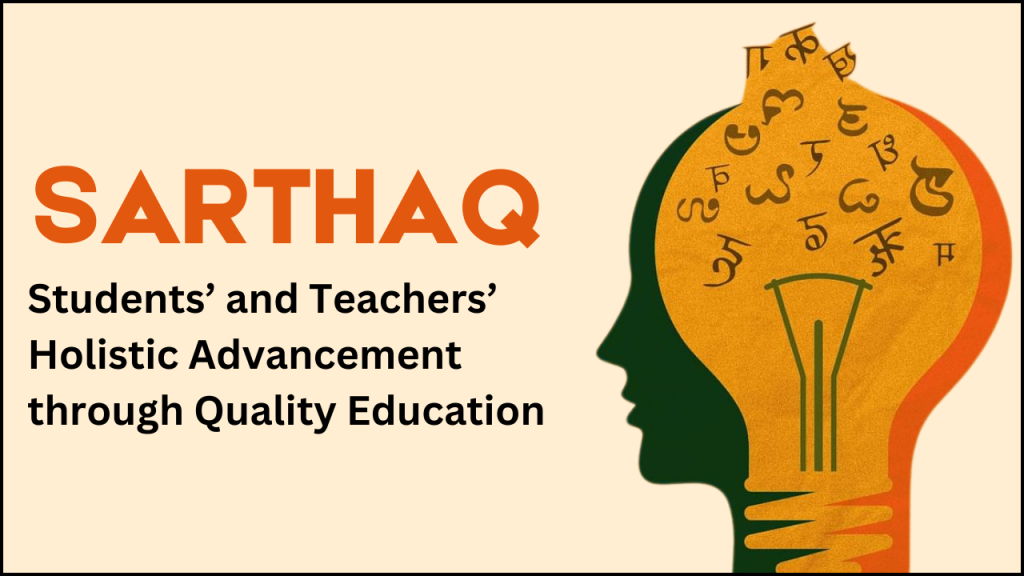
SARTHAQ, which stands for ‘Students’ and Teachers’ Holistic Advancement through Quality Education,’ is an implementation framework designed for the National Education Policy (NEP) 2020. Developed by the Department of School Education and Literacy, SARTHAQ aims to assist States and Union Territories in realizing the goals and objectives of NEP 2020.
Recent Developments A high-level meeting led by Union Education Minister Ramesh Pokhriyal focused on the implementation of NEP 2020. During this meeting, the SARTHAQ implementation plan was officially launched to streamline school education reforms.
This article explores SARTHAQ’s relevance to the IAS Exam and encourages aspirants to study the New Education Policy alongside other education-related topics.
Formation of SARTHAQ SARTHAQ was formulated through extensive consultations involving States, Union Territories, and autonomous bodies, receiving approximately 7177 suggestions. Between September 8 and September 25, 2020, the ‘Shikshak Parv’ festival facilitated discussions on NEP 2020 and its execution, garnering over 15 lakh recommendations.
Expert panels analyzed the suggestions to refine the plan, ensuring inputs from stakeholders were incorporated. Feedback from states yet to respond will be included as it becomes available.
Key Objectives of SARTHAQ
- Curriculum Reforms: Develop updated national and state curricula, including Early Childhood Care and Education (ECCE).
- Enrollment and Retention Goals: Increase Gross Enrolment Ratio (GER) and Net Enrolment Ratio (NER) while reducing dropout rates.
- Foundational Literacy and Numeracy: Ensure universal foundational literacy and numeracy for Grade 3 students by 2025.
- Teacher Education Enhancement: Improve the quality of teacher training programs.
- Experiential Learning: Focus on hands-on and skill-based learning approaches.
- Holistic Curriculum: Incorporate vocational training, arts, sports, environmental awareness, Indian knowledge systems, and 21st-century skills.
- Multilingual Education: Emphasize regional and mother-tongue-based instruction in early education.
- Infrastructure Development: Strengthen both physical and digital infrastructure to ensure accessibility and resource-sharing.
Key Features of SARTHAQ
- Federal Structure: Recognizes the concurrent nature of education and supports cooperative federalism.
- Implementation Framework: Provides a 10-year roadmap for executing NEP 2020.
- Local Adaptability: Allows States and Union Territories to modify the plan according to their needs.
- Enrollment Targets: Focuses on raising GER and NER while reducing dropouts.
- Digital Integration: Promotes technology in governance, educational planning, and classroom learning.
Future Prospects
- Cooperative Federalism: Given education’s place on the concurrent list, successful implementation requires collaboration between central and state governments. SARTHAQ’s federalist approach must be upheld in practice.
- Inclusivity in Education: Establishing ‘inclusion funds’ will help underprivileged students continue their education. Regulatory frameworks must oversee donations and benefits.
- Bridging the Digital Divide: Technology can amplify learning, but unequal access may widen social gaps. Governments must address disparities in digital education resources.
Conclusion
SARTHAQ offers a structured and flexible roadmap to implement NEP 2020, ensuring comprehensive educational reforms. Its success depends on collaborative federalism, inclusive policies, and technological integration. Addressing challenges like dropout rates, foundational literacy, and the digital divide will be key to realizing its vision for holistic and quality education.